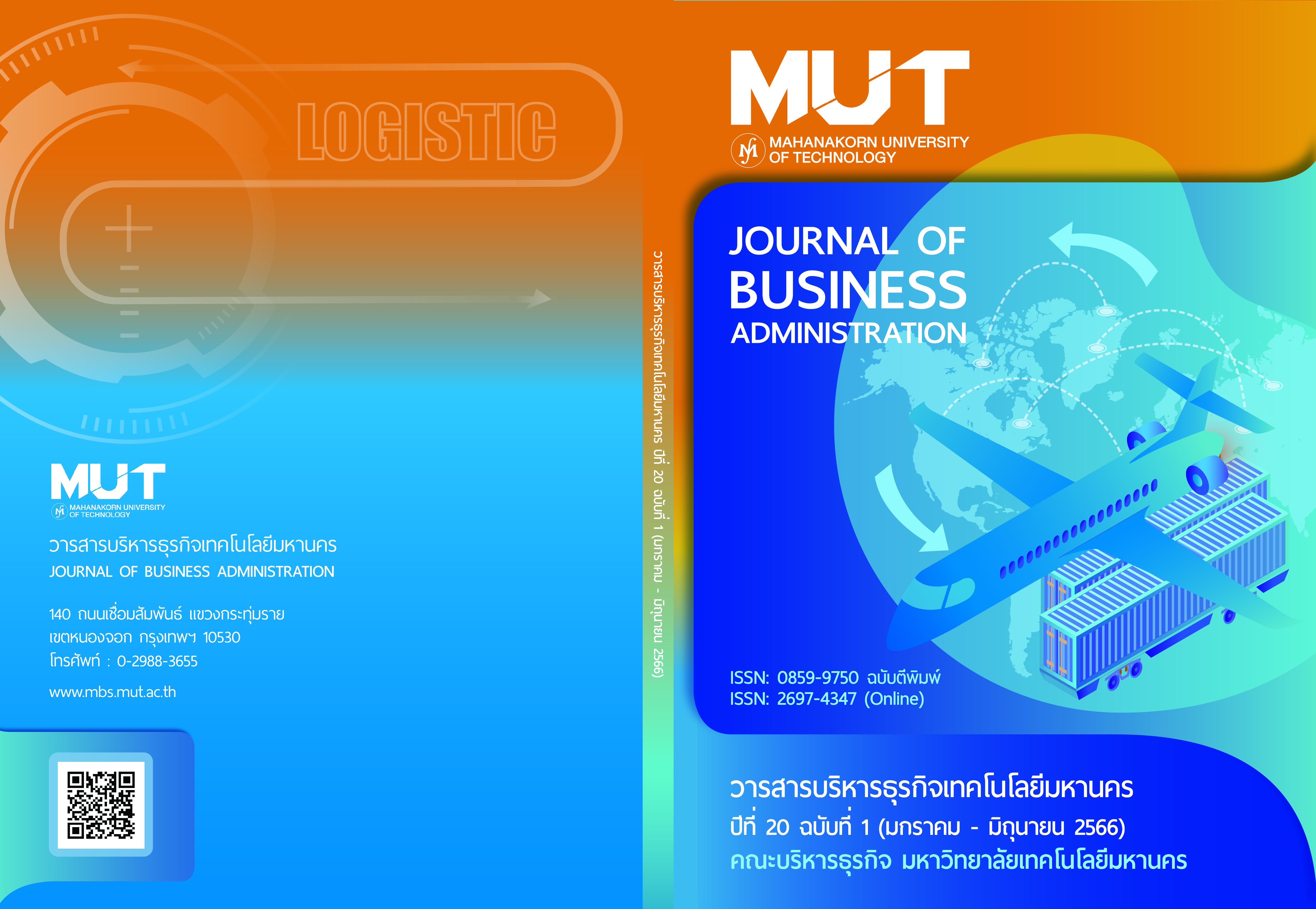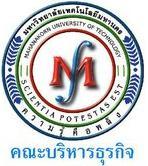การศึกษาเปรียบเทียบปัจจัยพฤติกรรมการเดินทางตามแผนและรูปแบบการเดินทางของนักท่องเที่ยวชาวไทยและชาวจีนที่มีต่อความตั้งใจเปลี่ยนรูปแบบการเดินทางด้วยรถไฟฟ้าความเร็วสูง
คำสำคัญ:
พฤติกรรมการเดินทางตามแผน, รูปแบบการเดินทาง, การเปลี่ยนรูปแบบการเดินทาง, รถไฟฟ้าความเร็วสูง, นักท่องเที่ยวบทคัดย่อ
งานวิจัยนี้ศึกษาผลกระทบปัจจัยเชิงพฤติกรรมการเดินทางตามแผนที่ส่งผลความตั้งใจเปลี่ยนรูปแบบการเดินทางเป็นรถไฟความเร็วสูงของนักท่องเที่ยวชาวไทยและชาวจีน และเปรียบเทียบปัจจัยพฤติกรรมการเดินทางตามแผนและรูปแบบการเดินทางในการตัดสินใจเลือกเดินทางด้วยรถไฟความเร็วสูงของกลุ่มนักท่องเที่ยวชาวไทยและชาวจีน กลุ่มตัวอย่างที่ศึกษา ได้แก่ นักท่องเที่ยวชาวไทยและชาวจีน จำนวนกลุ่มละ 400 คน เครื่องมือที่ใช้ในการเก็บรวบรวมข้อมูลคือแบบสอบถามที่แปลเป็นสองภาษา (ไทย-จีน) ผลการตรวจสอบคุณภาพเครื่องมือแสดงค่าครอนบาด 0.799-0.852 การวิเคราะห์ข้อมูลใช้การวิเคราะห์ถดถอยแบบพหุคูณ (Multiple regression analysis) และการวิเคราะห์ความแปรปรวน (One-Way ANOVA) เพื่อการทดสอบสมมติฐาน
ผลการทดสอบสมมติฐานพบว่านักท่องเที่ยวชาวไทยและชาวจีนมีทัศนคติส่วนบุคคลของนักเดินทางต่อการเดินทางด้วยรถไฟฟ้าความเร็วสูง (β=0.169: p<0.05, β=0.245: p<0.05 ตามลำดับ) การคล้อยตามบุคคลรอบข้าง (β=0.380: p<0.01, β=0.298: p<0.01 ตามลำดับ) และการรับรู้ความง่ายของบุคคล (β=0.158: p<0.05, β=0.280: p<0.01 ตามลำดับ) มีความสัมพันธ์เชิงบวกกับความตั้งใจในการเปลี่ยนมาใช้รถไฟฟ้าความเร็วสูงอย่างมีนัยสำคัญทางสถิติ ผลการเปรียบเทียบปัจจัยพฤติกรรมการเดินทางตามแผนในการตัดสินใจเลือกเดินทางด้วยรถไฟฟ้าความเร็วสูง พบว่านักท่องเที่ยวชาวไทยอาศัยทัศนคติส่วนบุคคลของนักเดินทางในการตัดสินใจเลือกการเดินทางมากกว่าชาวจีน (p<0.05) ด้านผลการเปรียบเทียบรูปแบบการเดินทางในการตัดสินใจเลือกเดินทางด้วยรถไฟฟ้าความเร็วสูง พบว่านักท่องเที่ยวชาวจีนคำนึงถึงความปลอดภัยมากกว่าชาวไทย นักท่องเที่ยวชาวไทยเน้นความสะดวกสบายมากกว่าชาวจีน และนักท่องเที่ยวชาวจีนให้ความสำคัญกับการบริการที่ดีมากกว่าชาวไทย (p<0.05)
References
Ajzen, I., and Fishbein, M. 1980. Understanding attitudes and predicting social behavior. Englewood Cliffs. NJ: Prentice-Hall.
Anantamongkolkul, C. and Khongma, T. 2021. ASEAN University Students Travel Behavioral Intention: An Application of the Theory of Planned Behavior. Journal of Thai Hospitality and Tourism. Vol. 16. No. 2. 3 – 17.
Bhandhasu, A. and Bejrananda, M. 2011. Travel Behavior in Regional City: A Case Study of Chiang-Mai City. Built Environment Inquiry Journal. Vol. 10. No. 1. 74 – 91.
Boonsopa, K. 2019. The Relationship between the Image of State Railway of Thailand and Purchase Decision: The Case Study of 115 New Trains. Master of Arts (Marketing Communication). Rajamangala University of Technology Phra Nakhon.
Chaichannawatik, B. and Limanond, T. 2013. Long Distance Travel behavior of Bangkok Residents: A study on mode choice. Kasem Bundit Engineering Journal. Vol.3.
No. 2. 57 – 72.
Chantana, S. 2021. The Relationship between the Behavior of Chinese Tourists on Managing Customer Relationships of Tourism Enterprises in Thailand. Journal of Management Science Review. Vol. 23. No. 2. 145 – 153.
Chomponuch, W. 2011. Factors affecting intention to shift mode from private car to public transport in bangkok. Master of Engineering (Civil Engineering). Chulalongkorn University.
Department of Rail Transport. 2020. Thai-China High-Speed Railway Project. Retrieved October 27, 2019 from https://www.drt.go.th/public-relations/pr22072022_01
Fishbein, M. and Ajzen, I. 2010. Predicting and changing behavior: the reasoned action approach. New York: Psychology Press.
Fornell, C. and Larcker, D.F. 1981. Structural Equation Model with Unobservable Variables and Measurement Error: Algebra and Statistics. Journal of Marketing Research. Vol. 18. No. 3. 382 – 388.
Gao, S. and Chubchuwong, M. 2020. The relationship between personal factors and behaviors of Chinese students travelling in Thailand. Suthiparithat Journal. Vol.34. No.112.
– 179.
Hair, J. F. et al. 2010. Multivariate Data Analysis: A Global Perspective. Upper Saddle River, N. J.: Pearson.
Jadesadalug, V. and Sangngern, K. 2018. Guidelines for the development of transport services for the elderly in Ratchathewi District, Bangkok. Veridian E-Journal, Silpakorn University. Vol. 11. No. 1. 3032 – 3047.
Krutbangyang, N. 2021. A Comparative Study of Purchasing Behavior of Chinese and European Travelers. Journal of Public and Private Management. Vol. 28. No. 1.
– 45.
Lorpoonkijsakul, P. 2019. China Tourists Behavior to Use Thai Railway Service for Tourism. Bachelor Degree of Arts (Asia Study). Silpakorn University.
Madden, T. J. et al. 1992. A comparison of the theory of planned behavior and the theory of reasoned action. Personality and Social Psychology Bulletin. 18. 3 – 9.
Makarapong, D. and Punnakitikashem, P. 2018. Behavior Intention of E-Ticket System of Public Transportation System Users. KMUTT Research and Development Journal. Vol. 41. No. 1. 115 – 126.
Naeohaengtham and Chuntuk. 2017. A Study Need Assessment of Service Provision High-Speed Rail In The Future A Case Study Bangkok-Huahin Route. Veridian E-Journal, Silpakorn University. Vol. 10. No. 3. 226 – 238.
Panyarak, B. and Vongsaroj, R. 2018. Image of Safety and Perception of Safety Management of Chinese Free and Independent Travelers in Bangkok. Kasetsart University Political Science Review Journal. Vol. 5. No. 2. 125 – 150.
Parasakul, L. 2019. International tourists’ expectation and their satisfaction with the shopping experience in Bangkok metropolis. Modern Management Journal. Vol.17 No.1.
– 92.
Parliamentary budget office. 2022. Opportunity and Challenge: High-Speed Railway Project Bangkok – Nong-khai node. The Secretariat of the House of Representatives Publishing: Bangkok.
Sawadepab, C. 2013. The Role of High-Speed Railway with China Tourism. Bachelor Degree of Arts (Asia Study). Silpakorn University.
Sawasdipanich, N. and Tiansawad, S. 2011. Instrument Translation for Cross-Cultural Research: Technique and Issues to be considered. Thai Journal of Nursing Council. Vol. 26 No.1, 19 – 28.
Seanyen, T. et al. 2020. Analysis of Dealing with COVID-19: The Impact on Aviation Industry. Journal of Multidisciplinary in Humanities and Social Sciences. Vol. 3. No. 2.
– 220.
Strategic Studies Center. 2022. Case Study “China - Laos High - Speed Railway: Opportunity and Challenge to Stability in Thailand”. National Defense Studies Institute. Bangkok.
Subboonrueng, H. and Sirirat, J. 2021. Thailand - China High - Speed Railway Project: Prospects for Northeastern Thailand Development. The Journal of the Thai Khadi Research Institute. Vol. 17. No. 2. 50 – 80.
Suwannakul, E. 2014. Thai Passengers’ Behavioral Tendency toward Travelling Bangkok – Chiang Mai with High Speed Rail Compared to Low Cost Airline. International Thai Tourism Journal. Vol. 10. No. 2. 87 – 100.
Vithivoravee. 2016. Factors influencing Thai tourists' decision to travel to international destinations: a case study of Thai tourists travelling to Scandinavian countries. Master of Arts (Tourism Management). Dhurakij Pundit University.
Wannayu, R. 2020. Bicycle Tourism Elements and Satisfaction That Affect the Behavioral Intention of Foreign Tourists in Cycling Tourism: A Case Study of Thonburi District. Master of Management (Integrated Tourism and Hospitality Management). National Institute of Development Administration.
Wongduen, J. and Ayasanond, C. 2019. Management of rail transport efficiency: a case study of Bangkok - Chiang Mai route. Social Science Journal of Prachachuen Research Network. Vol. 1. No. 2. 52 – 63.
Yamane, T. 1973. Statistics: An Introductory Analysis. 3rd Ed. New York: Harper and Row
Publications.
Yolao, W. 2015. The Concept of Service Marketing Mix of Which Affects the Decision to Change to Hi-Speed Rail Services of Low-Cost Airlines Passengers on the Route Bangkok-Phitsanulok. Naresuan University.
Zhou, Z. 2012. Measuring nonlinear dependence in time-series, a distance correlation approach. Journal of Time Series Analysis. Vol. 33. No. 3. 438 – 457.
Additional Files
เผยแพร่แล้ว
ฉบับ
บท
License

This work is licensed under a Creative Commons Attribution-NonCommercial-NoDerivatives 4.0 International License.
ข้อความ ข้อคิดเห็น ข้อมูล เนื้อหา รูปภาพ แผนภูมิ แผนผัง เป็นต้น ที่ปรากฏและแสดงในบทความต่างๆ ในวารสารบริหารธุรกิจเทคโนโลยีมหานคร ถือเป็นความรับผิดชอบโดยตรงของผู้เขียนบทความนั้นๆ มิใช่เป็นความรับผิดชอบใดๆ ของวารสารบริหารธุรกิจเทคโนโลยีมหานคร และมหาวิทยาลัยเทคโนโลยีมหานคร
บทความที่ตีพิมพ์ในวารสารบริหารธุรกิจเทคโนโลยีมหานคร ถือเป็นลิขสิทธิ์เฉพาะของคณะบริหารธุรกิจ มหาวิทยาลัยเทคโนโลยีมหานคร หากบุคคลหรือหน่วยงานใดต้องการนำทั้งหมดหรือส่วนใดส่วนหนึ่งไปเผยแพร่ต่อหรือเพื่อกระทำการใดๆ จะต้องได้รับการอนุญาตเป็นลายลักษณ์อักษรจากคณะบริหารธุรกิจ มหาวิทยาลัยเทคโนโลยีมหานครก่อนเท่านั้น

